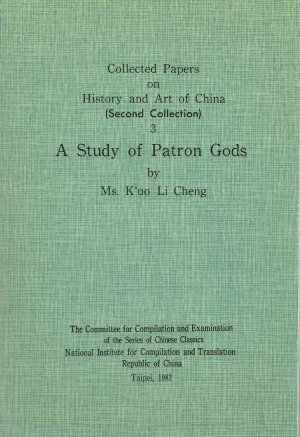

"Patron god" (Hang Shen,行神, literally, profession-god)is the title given to the originator, inventor or protector of any line of business. Popularly, it is called "Tsu Shih"(祖師)or "Tsu Shih Yeh"(祖師爺)meaning originator-teacher. A patron god may be a spiritual being attributed or assumed to be the inventor, originator or protector of a craft, trade or profession it may also be a past personage, legendary or real, believed tg be such.
Centered around the patron god and the worship of the same, collegues of the same field of living flock together, and, thus associations are formed, rules for the conducts of members made and interests of the members fortified. The leader of the association serves also as the high priest at the sacrifice offerings, such as on the birthday of the patron god,which all members are required to attend. After the sacrifice, meeting is held to discuss and decide upon association business, such as the election of new leader, standard prices for their serces and punishment of association delinquents. All such business is taken up before the patron god to show seriousness and fairness. Finally banquets are held and, sometimes, shows and plays are performed to please the patron god and, indeed, also the members as an additional efforts to incerase their affiliation and unity.
To show a general idea of the content of the book, the out line of the chapters is given below:
| I. | Introduction | ||
| II. | The definition and origin of patron gods. | ||
| III. | The classification. | ||
| A. | Classification according to the nature of the patron. | ||
| 1. | Human beings, legendary or real, who were or are supposed to have been the inventor or originator, of certain crafts, trades or professions. | ||
| 2. | Spiritual beings, attributed as the inventor or originator of certain crafsts, trades or professions. | ||
| B. | Classification according to the nature of associations. | ||
| 1. | Patron gods of crafts, generally the inventors of the crafts. | ||
| 2. | Patron gods of trades, generally the originatiors of certain lines of trade. | ||
| 3. | Patron gods of professionals, generally the originators of certain lines of profession. | ||
| IV. | Sources of materials. | ||
| 1. | Folk accounts and popular books. | ||
| 2. | Materials found in anecdotes and novels. | ||
| 3. | Foreign books on the subject. | ||
| Note: Materials on patron gods are found completely lacking in the classical history books. Even the records of the associations do not seem to give any detailed account on why this or that deity or person has been reverenced as their patron god. The only available sources are legends, old anecdotes, some involu nt ary refernces made, passim, in the novels and some popular books. | |||
| V. | Patron gods of crafts: | ||
| 1. | Patron god of house builders. | ||
| 2. | Patron god of furniture makers. | ||
| 3. | Patron god of tailors: | ||
| 4. | Patron god of food manifacturers. | ||
| 5. | Patron god of printers. | ||
| 6. | Patron god of pharmacists. | ||
| 7. | Patron god of practicians of a number of other small crafts. | ||
| VI. | Patron gods.of trade: | ||
| 1. | Patron god of the merchants of building materials. | ||
| 2. | Patron god of the merchants of furniture. | ||
| 3. | Putron god of dress sellers. | ||
| 4. | Patron god of food venders. | ||
| 5. | Patron god of book sellers. | ||
| 6. | Patron god of drug store operators. | ||
| 7. | Patron gods of a number of other kinds of businessmen. | ||
| VII. | Patron gods of the professionals: | ||
| 1. | Patron god of laborers. | ||
| 2. | Patron god of white colar workers. | ||
| 3. | Patron gods of practicians in arts and show business. | ||
| VIII. | Detailed account on the various ceremonies of sacrfices offered by different associations. | ||
| IX. | Temples and stone tablets dedicated to the various patron gods in Peiping. | ||
| 1. | Temples of patron gods in the Interior City. | ||
| 2. | Temples of patron gods in the Outer City. | ||
| 3. | Temples of patron gods in the vicinity of Peiping. | ||
| Note: Peiping, having been the capital of China for about 700 years, had witnessed the flourishing of various associations of different professions and occupations and holds a great number of temples dedicated to the various patron gods. Special treatment is, therefore, given to the great city. | |||
Stone tablets in these temples provide quite a bit of informations on the patron gods. A list of such, important tablets is made in the book.